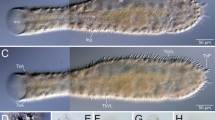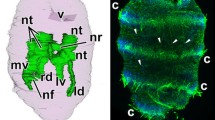Abstract
Regional and age differences in the epidermis of the redia ofP. acanthus have been studied by transmission electron microscopy. The depth of the outer cytoplasmic epidermis increases by four times from stage I to stage III and the microvilli double their length and branch by stage II. Electron-dense and electron-lucent membrane bound bodies are present in all stages, the latter being released onto the surface as vesicles. Multivesicular bodies appear in stage III. All are formed in one type of secretory epidermal cell body. Anterior and posterior concentric folds, of thickened outer cytoplasmic epidermis only, increase the surface area and also the diameter of the redia on contraction. In stages I and II the apical regions of the ventro-lateral processes and birth papilla, and the lattice pattern on the posterior papilla, each consisting of thickened outer cytoplasmic epidermis only, may provide rigidity and support during migration. The uniciliate sensory receptors appear to be mechanoreceptors.
Similar content being viewed by others
References
Bennett CE (1975) Surface features, sensory structures, and movement of the newly excysted juvenileFasciola hepatica L. J Parasitol 61:886–891
Bils CF, Martin WE (1966) Fine structure and development of the trematode integument. Trans Am Microsc Soc 85:78–88
Blair DG, Burt MDB (1976) Observations on the ultrastructure of papillae and associated sensilla on the scolex ofMonoecocestus americanus (Stiles, 1895) (Cestoda: Anoplocephalidae). Can J Zool 54:802–806
Dixon KE (1970) Absorption by developing cercariae ofCloacitrema narrabeenensis (Philophthalmidae). J Parasitol 56:416–417
Ehlers U, Ehlers B (1977) Monociliary receptors in interstitial Proseriata and Neorhabdocoela (Turbellaria, Neoophora). Zoomorphologie 86:197–222
Ginetsinskaya TA, Mashanskii VF, Dobrovolskii AA (1965) Ultrastructure of the tegument and the method of feeding in rediae and sporocysts (Trematoda). Dokl Akad Nauk SSSR 166:1003–1004
Halton DW, Lyness RAW (1971) Ultrastructure of the tegument and associated structures ofAspidogaster conchicola (Trematoda: Aspidogastrea). J Parasitol 57:1198–1210
Horridge CA (1965) Non-motile sensory cilia and neuromuscular junctions in a ctenophore independent effector organ. Proc R Soc Lond (Biol) 162:333–350
Irwin SWB, Theradgold LT, Howard NM (1978)Cryptocotyle lingua (Creplin) (Digenea: Heterophyidae): observations on the morphology of the redia, with special reference to the birth papilla and release of cercariae. Parasitology 76:193–199
Krupa PL, Bal AK, Cousineau GH (1967) Ultrastructure of the redia ofCryptocotyle lingua. J Parasitol 53:725–734
Krupa PL, Cousineau GH, Bal AK (1968) Ultrastructual and histochemical observations on the body wall ofCryptocotyle lingua (Trematoda). J Parasitol 54:900–908
Køie M (1971a) On the histochemistry and ultrastructure of the redia ofNeophasis lageniformis (Lebour, 1910) (Trematoda: Acanthocolpidae). Ophelia 9:113–143
Køie M (1971b) On the histochemistry and ultrastructure of the daughter sporocyst ofCercaria buccini Lebour, 1911. Ophelia 9:145–163
Køie M (1971c) On the histochemistry and ultrastructure of the tegument and associated structures of the cercaria ofZoogonoides viviparus in the first intermediate host. Ophelia 9:165–206
Lyons KM (1969a) Compound sensilla in monogenean skin parasites. Parasitology 59:625–636
Lyons KM (1969b) Sense organs of monogenean skin parasites ending in a typical cilium. Parasitology 59:611–623
Lyons KM (1972) Sense organs of monogeneans. In: Canning EU, Wright CA (ed) Behavioural aspects of parasite transmission, Zool J Linn Soc Suppl 51:181–199
MacRae EK (1967) The fine structure of sensory receptor processes in the auricular epithelium of the planarianDugesia tigrina. Z Zellforsch Mikrosk Anat 82:479–494
Matricon-Gondran M (1969) Étude ultrastructurale du syncytium tégumentaire et de son évolution chez des Trématode Digénétiques. CR Acad Sci Paris 269:2384–2387
Matricon-Gondran M (1971) Étude ultrastructurale des récepteurs sensoriels de quelques Trématodes Digénétiques larvaires. Z Parasitenkd 35:318–333
Morris GP, Threadgold LT (1967) A presumed sensory structure associated with tegument ofSchistosoma mansoni. J Parasitol 53:537–539
Rees G (1966) Light and electron microscope studies of the redia ofParorchis acanthus Nicoll. Parasitology 56:589–602
Rees G (1971) The ultrastructure of the epidermis of the redia and cercaria ofParorchis acanthus Nicoll. A study by scanning and transmission electron microscopy. Parasitology 62:479–488
Rees FG (1980) Surface ultrastructure of the redia ofParorchis acanthus Nicoll (Digenea: Philopthalmidae). Z Parasitenkd 63:33–46
Reynolds ES (1963) The use of lead citrate at high pH as an electron-opaque stain in electron microscopy. J Cell Biol 17:207–212
Silk MH, Spence IM (1969) Ultrastructural studies of the blood flukeSchistosoma mansoni III. S Afr J Med Sci 34:93–104
Author information
Authors and Affiliations
Rights and permissions
About this article
Cite this article
Gwendolen Rees, F. The ultrastructure of the epidermis of the redia ofParorchis acanthus nicoll (Digenea; Philophthalmidae). Z. Parasitenkd. 65, 19–30 (1981). https://doi.org/10.1007/BF00926550
Received:
Issue Date:
DOI: https://doi.org/10.1007/BF00926550




